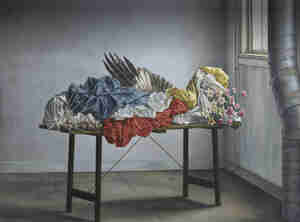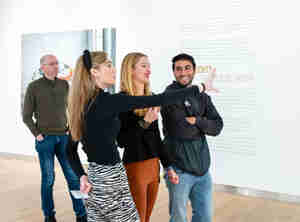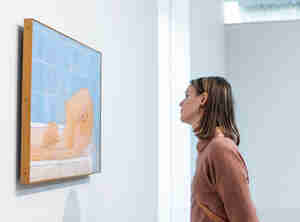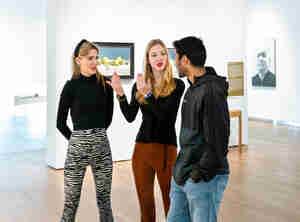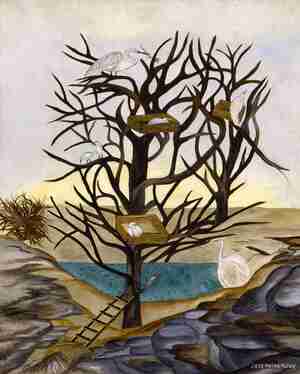Uninhibited, imaginative and touchingly uncomplicated. This appears to be the irresistible appeal of naive realism. But this seemingly straightforward surface conceals a rich artistic spectrum. And its unschooled makers were on the cusp of modern art. Museum MORE is uniting 80 paintings by renowned and less well-known naive realists from the United States and Europe. A unique transatlantic assembly of distinctive artworks and captivating life stories. Inspired by the pioneering exhibition Masters of Popular Painting at New York’s Museum of Modern Art 85 years ago, Museum MORE is reuniting works by many artists featured in the original exhibition. Naive Realism | From Rousseau to Grandma Moses features remarkable art by self-taught artists including Henri Rousseau, Camille Bombois, Séraphine Louis, Nikifor, Grandma Moses, John Kane, Horace Pippin and Morris Hirshfield.
Without formal artistic schooling, naive realists on both sides of the Atlantic scrambled to the artistic peak between 1920 and 1945. Their seemingly straightforward landscapes, intimate domestic scenes, sincere portraits and colourful still lifes fired the imagination of the public and the artistic establishment.

Morris Hirshfield, Girl with flowered dress, 1945, American Folk Art Museum, New York, gift Donna & Carroll Janis.
Unique visual language
The popularity of work by naive realists boomed in the turbulent period between the two world wars, perhaps aided by a longing for fictional days of yore, in which the world still appeared comprehensible. But more importantly: visual art made by ‘ordinary’ people was suddenly acknowledged by the official art scene. Renowned museums and art collectors added work by talented self-taught artists to their collections. These artists were no longer viewed as amateurs, but rather as fully-fledged artists with an authentic voice and a unique visual language.
In a sense, they are the embodiment of an everyday heroism, due to the extraordinary position they secured: sometimes by design, and sometimes by chance. But it was certainly not a coordinated effort. The artists – some of whom only turned to art in later life, alongside holding down often poorly paid jobs – probably did not know each other. And they were definitely not a group with a defined artistic plan of attack. They were individuals with very different backgrounds. Only connected by their idiosyncratic, often lavishly detailed and intense portrayal of reality.
Henri Rousseau
Henri Rousseau, nicknamed Le Douanier, was undeniably the most significant pioneer leading the advance of the naive realists. The French customs officer was discovered in circa 1900 and embraced by colleagues with academic art schooling such as Félix Vallotton and Pablo Picasso. In Rousseau’s unschooled work, the then Parisian avant-garde saw something revolutionary: art that returned to the unaffected core. Averse to conventional rules, unbridled and direct. A source of inspiration for artists seeking liberation. And for those who were shackled by an intellectual approach to their profession. Rousseau, once jeered by some critics for his ‘childish’ art, showed them a way out. His approach and visual language gave avant-gardists an extra boost as they rocketed towards cubism and New Objectivity.

Henri Rousseau, Tropical forest with monkeys, 1920, Courtesy National Gallery of Art, Washington, John Hay Whitney Collection.

John Kane, Turtle Creek Valley, No. 1, c. 1932-34, Westmoreland Museum of American Art.
New Masters
After his death in 1910, Rousseau even became one of the patriarchs of naive realism. In Europe, but also in the United States, where he exhibited alongside the artistic vanguard of the time. And where the Scottish immigrant John Kane was considered his equal. The US is also where Horace Pippin, a war veteran, became one of the first black artists to achieve success in a heavily segregated society. The Museum of Modern Art (MoMA) in New York played a crucial role in the unprecedented rise in popularity of the naive realists. It gave Josephine Joy the opportunity to become the first ever female artist to hold a solo exhibition at the MoMA. And the museum organised the blockbuster exhibition Masters of Popular Painting in 1938, the culmination of three decades of artistic discoveries.
Trans-Atlantic meeting
The MoMA-exhibition features an enormous selection of 150 works, selected by the curators for their individual quality, which far exceeds the average standard of ‘anonymous folk art’. The exhibition is a collaboration with Musée de Grenoble, and unites dozens of American and European, mainly French ‘modern primitives’. Paintings by artists including Camille Bombois, Séraphine Louis and André Bauchant take pride of place, naturally alongside Rousseau.
It was only once some naive realists became truly popular in the 1940s, such as the American former farmer Grandma Moses, that the doors to art institutions once again started to close. It is even rumoured that a focus on naive realism cost Alfred Barr, the first director of the MoMA, his job. It is likely that exhibiting the totally unorthodox art of tailor Morris Hirshfield finished him off. Barr was a passionate promotor of self-taught artists, keen to break down barriers between them and ‘established’ artists, and many critics thought that he had gone a step too far. The tide has changed.

Grandma Moses, Shenandoah, South Branch, before 1938, private collection, Courtesy Galerie St. Etienne, NY. Kallir Research Institute © Grandma Moses Properties Co., New York

Nikifor, Nikifor En Route, undated, Stedelijk Museum, Amsterdam
The big picture
The impact of the renowned naive realists working in this period on art history is now undisputed. The field is even being reassessed, with recent international exhibitions and publications rekindling debate on how we should refer to these artists. ‘Self-taught artists’ is (once again) a popular term in the United States, and terms such as modern primitives, Sunday painters and outsiders have all been used in the past century. Museum MORE uses the term ‘naive realists’ because these artists fit seamlessly into the larger art historical story of realistic art. From then, and now.
The exhibition Naive Realism | From Rousseau to Grandma Moses is inspired by the famous, pioneering MoMA exhibition, and 85 years later, reunites work by many European and American artists. Their last ‘reunion’ in the Netherlands was in 1964. Museum MORE is home to a broad spectrum of realistic art, and hence the museum’s own collection is ideal for providing the context necessary to understand naive realism. Work by Dutch naive realists, such as Sipke Houtman and Sal Meijer, will hence be displayed alongside that of their international colleagues.
Exquisite loans
For the curation of the exhibition and the production of the exhibition catalogue, Museum MORE curators Marieke Jooren and Sito Rozema were generously assisted by Katherine Jentleson, Merrie and Dan Boone Curator of Folk and Self-Taught Art at the High Museum of Art in Atlanta. The tour de force of uniting 80 highlights would not have been possible without exquisite loans from private collections and museums. Works from the United States have been loaned from institutions including the National Gallery of Art and the Smithsonian Museum of American Art in Washington D.C. In Europe, Museum MORE was warmly assisted by institutions including Museé l’Orangerie in Paris, the French Fondation Dina Vierny and the Zander Collection in Germany.
This exhibition is made possible with the generous support of the Prins Bernhard Cultuurfonds and HIZKIA.

Sal Meijer, Cat on table, undated, private collection

Featured artists
André Bauchant, Camille Bombois, Emile Branchard, Pedro Cervántez, Adolf Dietrich, Miep Dehé, Jean Ève, Victor Joseph Gatto, Morris Hirshfield, Sipke Houtman, Thorvald Arnst Hoyer, Josephine Joy, John Kane, Lawrence Lebduska, Séraphine Louis, Sal Meijer, Grandma Moses, Nikifor, Dominique Peyronnet, Horace Pippin, Henri Rousseau, René Rimbert, Aloys Sauter, Abraham Smalt, Adalbert Trillhaase, Louis Vivin.
Book
The exhibition is accompanied by a lavishly illustrated publication, authored by Marieke Jooren, Sito Rozema and Katherine Jentleson. Language English/Dutch. Publisher WBooks. Approx. 100 images, 144 pages, ISBN 9789462585423, € 29.95.
Activities
In addition to organising special workshops, guided tours and flash lectures, Museum MORE will be screening the award-winning French film Séraphine (2008) by director Martin Provost. With thanks to film distributor Cinéart.



